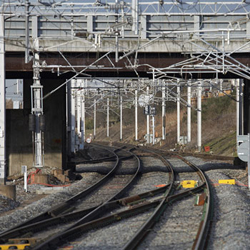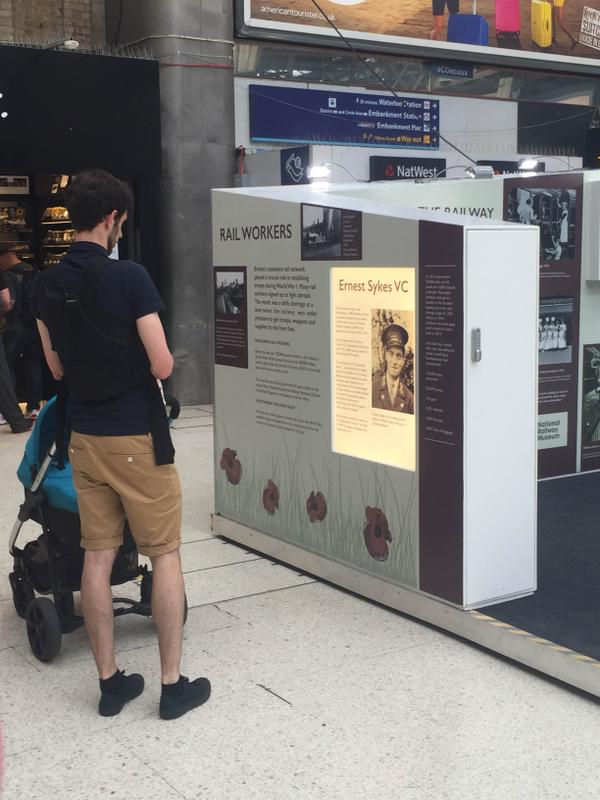 According to an article in the Rail Tecnology Magazine “the railway across the north needs a “bigger, more expensive, and transformational” solution to fix its historical lack of investment, because what is committed now simply is not enough, rail bosses have said.”
According to an article in the Rail Tecnology Magazine “the railway across the north needs a “bigger, more expensive, and transformational” solution to fix its historical lack of investment, because what is committed now simply is not enough, rail bosses have said.”
The leaders of Transport for the North (TfN) and Northern Rail, David Brown and Alex Hynes, have agreed that, although the next 4 years will see the issue of under investment being addressed, it is still not enough to make all the changes required to make this one of the best regions in the world.
“At the moment, we have to compromise all the time,” Hynes added.
The Flying Scotsman has arrived triumphant in York.
A name that is instantly recognisable as one of the most famous steam trains in the world, The Flying Scotsman has now been restored to its former glory and taken up residence in the National Rail Museum in York.
The train left Kings Cross station on the morning of Thursday 25 February 2016, and arrived in York a 13:20.
On board, for this journey were 297 passengers, some of whom paid up to £450 for a ticket to travel on the train. Amongst the VIP guests was Ron Kennedy, an 83-year-old who drove the Flying Scotsman from 1956 until it was retired in 1963.
Crowds gathered at Kings Cross to see The Flying Scotsman leave London, and thousands more people lined the route all the way to York. There were a couple of incidents where excited trainspotters on the track forced the train to slow down, and one poor soul who waited to film the train as it went by, had his view obliterated by an unfortunately timed Virgin train going in the opposite direction.
History of the Flying Scotsman
Locomotive No. 1472 Flying Scotsman was designed by Sir Nigel Gresly, and built for London and North Eastern Railway (LNER) at Doncaster Works in 1923. In 1924 it was selected to appear at the British Empire Exhibition in London, and was renumbered 4472, and given the name ‘Flying Scotsman’ after the London to Edinburgh route that it covered.
The Flying Scotsman set a world speed record in 1934 when it became the first train to officially reach a speed of 100 mph. It remained in service on the Edinburgh to London service until 1963 when it was retired. In its career, the Flying Scotsman had clocked up an impressive 3,341,000 km. After retirement the train spent time in the USA and in Australia where it set the record for the longest non-stop run by a steam locomotive when it ran 711 km in August 1989.
The Flying Scotsman is 21m long, weighs about 96 tonnes and has a top speed of 100mph. It was bought by the National Railway Museum (NRM) in 2004, using £415,000 in public donations, a £365,000 gift from Sir Richard Branson and a £1.8m grant from the National Heritage Memorial Fund. The restoration cost £4.2m, and took 10 years to complete.
The Flying Scotsman is currently on show at the National Railway Museum from 26 February until 7 March and again from 25 March and 8 May. Find out more about seeing this magnificent locomotive
Great Western Main Line will see its electrification programme rolled out on the following dates:

- Maidenhead to Didcot – December 2017
- Didcot to Wootton Bassett Junction – December 2018
- Wootton Bassett Junction to Bristol Parkway – December 2018
- Reading to Newbury – December 2018
- Bristol Parkway to Cardiff – December 2018
- Didcot to Oxford – June 2019
- Wootton Bassett Junction to Bristol Temple Meads – February 2019-April 2020
This update comes after numerous set-backs to the Great Western electrification scheme which have included poor productivity, inefficiency, design standard issues and increased costs.
Costs are currently estimated at between £2.5bn and £2.8bn, a far cry from the original £874m in 2012.
The Bristol Parkway to Cardiff works were originally scheduled for 2017 but are now set for completion by December 2018.
Find out more about this project from Great Western
South Western Ambulance Service is inviting the public to share a showcase event on Exeter’s Cathedral Green on Thursday 17th September 2015 from 1000 until 1600. Visitors can view the numerous vehicles on display, speak to ambulance staff, receive a free health-check and find out more about the organisation. This event forms part of the South Western Ambulance Service Annual General Meeting.
There will be numerous presentations during the day, as well as activities for children.
Members of the public are invited to enjoy the day out, and at the same time show support for their ambulance service.
Find out more here
A new programme of improvements for London’s Waterloo station has just been unveiled.
About 100 million people per year pass through Waterloo station, and it has had no major upgrades since the 1930s.
This project will see the strengthening of some bridges, and the extension of 4 platforms.
Planning permission has just been submitted, and the project is scheduled for completion at the end of 2016.
Find out more Wessex Capacity Improvement Programme


The Digital Future – a live debate on the role of digital technology in rail transport.
Sponsored by Siemens Mobility, this event will take place on Wednesday 9 September from12: – 13:00.
Listen to key speakers discuss some of the key issues facing the rail industry and join in the interactive debate.
Streamed live from London’s Tower Bridge Studio, this broadcast will feature the following speakers:
- David Horne | CEO – Virgin Trains East Coast
- Wim Fabries | Programme Director – ERTMS, Ministry of Infrastructure & Environment, Netherlands
- Jerry England | Group Director – Digital Railway, Network Rail
- Dr Jochen Eickholt | CEO – Siemens Mobility
The event will be moderated by Chris Jackson, Editor-in-Chief, Railway Gazette Group
The issues to be discussed are:
- What can digital technology offer in the search additional capacity as the demand for rail transport continues to increase? What is the role of communications-based train control and driver advisory systems?
- How might advanced train planning and traffic management systems help to improve operational performance and reliability?
- What degree of automation might be appropriate for main line railways, and what lessons can be gained from experience in the metro sector? Will ERTMS and CBTC converge in the next generation of train control systems?
- Where does the digital revolution open up opportunities to improve passenger information, journey planning and smart ticketing? How can railways meet customer demands to be constantly connected through Wi-Fi on trains, or the real-time tracking of freight consignments?
- What are the benefits of real-time monitoring and automation in the inspection and maintenance processes, for both trains and infrastructure?
- How will the introduction of advanced technology impact on safety? What are the human factors affecting drivers and train crew, or other staff?
- Can the railway sector attract and retain the skilled staff needed to develop, operate and maintain advanced technologies in the face of competition from other industries?
If you are interested in joining the debate then register here to listen to the presentations live and share the debate.

Image from Network Rail
An exhibition by the Rail Delivery Group highlighting the important role of women in the railways during WW1 has just opened in London.
This free exhibition will be at London Charing Cross station until 10 August when it will move to King’s Cross station until August 31. After this it will be touring around the country – details of future locations will be announced here.
The railway played an important part in WW1, transporting troops, horses, military equipment and medical supplies around the country. Almost 100,000 men left the railways to fight in WW1 leaving a huge skills shortage. At the start of the war there were about 13,000 women, mainly in domestic positions, in the railways. By the end of the war there were over 70,000, in a vast range of roles.
The exhibition includes photos, soldiers’ letters and unique memorabilia commemorating the role of the railways in WW1 – the railway workers who fought in the war, including the soldiers who lost their lives, the soldiers honoured for their bravery, and of course, the women, who kept the railways at home running.
Phil Hufton, managing director of operations at Network Rail added: “Without the contribution of women, the railway could not have played such a significant part in the war effort. We owe a great debt to them and to the thousands of railway workers who fought. It is important for us to know their stories and ensure that they are not forgotten. This exhibition, which will be touring the country, has been created by the rail industry as a reminder to us all.”
Exhibition photographs have been supplied by the National Railway Museum. All relevant historical images accompanying this press release should be credited to the National Railway Museum.
The Emergency Services Show is scheduled for Sunday 13 September 2015, and the organisers are delighted to announce that the show has just been awarded charitable trust status.
 The Emergency Services Show was started in 2005 by a committee of volunteers from Wiltshire Police, Wiltshire Fire & Rescue Service, South Western Ambulance Service and the Highways Agency. Their mission was to raise some much needed funds, highlight some essential community safety messaging, raise the awareness of some of the lesser known blue light services and demonstrate the collaborative working of all the Emergency Services.
The Emergency Services Show was started in 2005 by a committee of volunteers from Wiltshire Police, Wiltshire Fire & Rescue Service, South Western Ambulance Service and the Highways Agency. Their mission was to raise some much needed funds, highlight some essential community safety messaging, raise the awareness of some of the lesser known blue light services and demonstrate the collaborative working of all the Emergency Services.
Last year’s show raised over £30,000.00 and the organisers are hoping that this 10th anniversary show will be even more successful.
2015 sees the start of a new e-ticketing solution which should speed up the ticket buying process, and reduce queuing to get into the show – buy tickets online
The Emergency Services Show 2015 is looking forward to featuring some of the great attractions from 2014 as well as some new ones
- Wiltshire Police’s dog section – both searching for drugs and tackling armed criminals
- South Western Ambulance Service’s Hazardous Area Response Team
- Wiltshire Fire & Rescue Service’s animal rescue specialists
- Avon Fire & Rescue Service showing the dangers of a chip pan fire
- A multi-agency road traffic collision simulation
- Attendance of both Wiltshire Air Ambulance and Great Western Air Ambulance
- A wide range of new and vintage emergency vehicles
- Fire engine and police car rides
- Ride in a Monster Truck
- Try a Go at Motorsport at the Go Motorsport Arena
- A fairground, model aircraft display, go-karting and much more!
- Community safety advice
- Recruitment information
- Trade Stands
This show promises to be a great day out and will raise some much needed funds for these incredible services. Do go if you can.
The next InnoRail Conference takes place in Budapest from 14-16 October 2015

The first InnoRail conference was held in October 2013, and attracted 303 participants from 18 countries. 14 speakers from Hungary and 32 from other countries shared their views on various fields of railway infrastructure, discussing practical issues and presenting novel innovative developments, tools and methods.
Safe rail transport is a priority of the European Union. It has trebled the funds available for research and development for the European railway network. InnoRail hopes to contribute to this through organizing this European rail conference.
This year’s InnoRail Conference will include rail experts from all over the world. InnoRail 2015 is expected to attract designers, contractors, suppliers and scientists.
Some of the topics to be include in this year’s InnoRail include:
- Infrastructure construction and management
- Telecommunication, signalling, traffic management
- Energy supply, catenaries and lighting technology
- Rolling stock development, production, operation and maintenance
- Rail bridges and structures
Visit InnoRail for more details and booking information
Crossrail tunnelling is nearing completion and by the end of June all tunnelling should have been completed. What is currently Europe’s largest engineering project has produced millions of tonnes of earth that needs to be disposed of. Unlikely as it seems, this has been shipped off to Wallasea Island, off the east coast of England, to create one of the largest nature reserves in Europe. Crossrail will have imported 7.5 million cubic metres of soil and raised the land so that there will be 2 million cubic metres of water rather than the 11 million that there was before the project.
Wallasea Island was created by Defra in 2006 as part of a managed realignment scheme for wintering bird whose natural habitat had been lost to development. The site now supports over 12,000 waterfowl.
The RSPB through Natural England manages the site on behalf of Defra, and Wallasea is now the largest coastal project of its type in Europe.
It aims to combat threats from climate change and coastal flooding by recreating the ancient wetland landscape of mudflats and saltmarsh, lagoons and pasture. It will also help to compensate for the loss of such tidal habitats elsewhere in England.
When it is completed Wallasea Island will boast a varied wetland landscape with over nine miles of access routes, and a range of visitor facilities.
The project is not due for completion until 2025, but the sea wall is already open to the public at Allfleets Marsh Trail is already proving to be popular for birdwatching, walking and just getting away from it all.
Find out more from Crossrail and the RSPB


